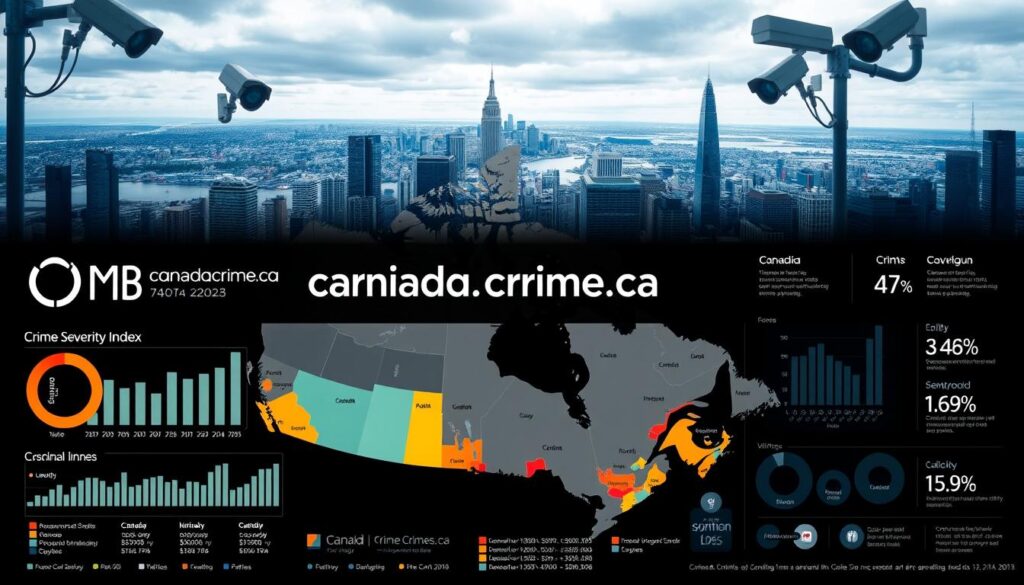Canada has witnessed significant shifts in its crime landscape over the past few decades. According to Statistics Canada, the overall crime rate had been steadily declining since the late 1990s, as measured by the Crime Severity Index (CSI) and the Violent Crime Severity Index (VCSI).
However, since reaching an all-time low in 2014, Canada has seen a gradual increase in crime rates. The CSI rose by 2% in 2023, marking the third consecutive year of increase. This trend reversal has sparked interest in understanding the underlying factors contributing to the shift.
The recent uptick in crime is not uniform across all categories. Statistical analysis reveals notable increases in fraud, extortion, and child pornography cases, indicating a complex and evolving crime environment. Understanding these trends is crucial for policymakers and legal professionals seeking to address the root causes of crime and improve public safety.
Overview of Crime in Canada
Understanding crime in Canada requires a nuanced approach, taking into account historical trends and statistical measures. The country’s crime landscape is complex, with various factors influencing its trajectory.

Historical Crime Trends
Historical crime trends in Canada show a significant long-term decline in violent crime since the mid-1970s. The homicide rate, for instance, has fallen by over 40% from its peak in 1975. This decline is a notable trend, indicating a shift towards safer communities. However, recent data suggests that while violent crime has generally decreased, there has been a concerning uptick in the overall Crime Severity Index (CSI) since 2015.
The CSI, developed by Statistics Canada, provides a more comprehensive measure of crime than simple crime rates by weighting crimes according to their seriousness. More serious crimes like homicide and sexual assault have a greater influence on the index than less serious offenses like minor theft.
The Crime Severity Index Explained
The Crime Severity Index is a critical tool for understanding crime trends in Canada. It accounts for both the volume and relative severity of crimes, offering a nuanced picture of the crime landscape. In 2023, the CSI rose by 2%, marking the third consecutive year of increase. This rise was significantly influenced by an increase in reported fraud, extortion, and child pornography cases, which soared by 52% in 2023.
By examining the CSI alongside traditional crime rates, policymakers can gain a more complete understanding of public safety challenges. The index demonstrates that while Canada remains relatively safe by global standards, specific crime categories warrant increased attention.
Current Canada’s Crime Rate Analysis
Understanding Canada’s current crime rate requires examining the latest statistical trends and the factors that influence them. In 2023, Canada experienced a total of 778 homicides, marking a decrease of 104 cases compared to the previous year. This change reflects a complex crime landscape that warrants closer examination.
Recent Statistical Trends
The overall crime rate in Canada stands at 5,843 incidents per 100,000 people as of 2023, showing a 2.5% annual increase. Despite this rise, the Violent Crime Severity Index remained relatively stable at 99.5. However, the Non-violent Crime Severity Index increased to 73.5, driving the overall rise in crime measurements. Gang-related homicides continue to be a concern, accounting for approximately 22% of all homicides, with 78% of these being committed with firearms, predominantly handguns. For more detailed statistics, visit Canada Crime Rate.
Furthermore, hate crimes saw a significant increase of 32%, reaching 4,777 reported incidents in 2023. The proportion of women killed by their spouse or intimate partner was approximately five times higher than that of men, highlighting a troubling pattern of gender-based violence.

Factors Influencing Crime Rates
Several factors contribute to the fluctuations in Canada’s crime rates. Economic factors, including income inequality and unemployment rates, correlate with certain types of property crimes across different regions. Demographic shifts, urbanization patterns, and social cohesion levels also play a significant role in influencing crime rates in Canadian communities.
The COVID-19 pandemic created significant disruptions in crime patterns, with initial decreases in some categories followed by increases as restrictions were lifted. Additionally, technological advancements have created new criminal opportunities, such as cybercrime, while enhancing law enforcement capabilities to detect and respond to traditional crimes. For a broader understanding of crime in Canada, refer to Wikipedia’s Crime in Canada page.
Types of Crime in Canada
Crime in Canada manifests in multiple forms, including violent and property crimes, each with distinct patterns and trends. Understanding these different types of crime is essential for developing effective strategies to combat them.
Violent Crime Statistics
Violent crime in Canada encompasses a range of offenses, including homicide, sexual assault, physical assault, robbery, and harassment. In 2022, Canada reported 2.25 homicides per 100,000 population, a rate that remains relatively low by international standards but varies significantly across provinces and territories. Sexual assault reports have seen an increase, with 90 incidents per 100,000 population, reflecting both a potential rise in occurrences and a greater willingness of victims to report such crimes.
Hate crimes have also seen a troubling increase, rising by 32% to 4,777 incidents in 2023, with the majority targeting religious groups or individuals based on their sexual orientation. This surge underscores the need for continued efforts to combat discrimination and ensure public safety.
- Homicide rates vary significantly across different regions.
- Sexual assault reports have increased, indicating both a rise in incidents and greater reporting.
- Hate crimes targeting religious groups and sexual orientation have seen a significant increase.
Property Crime Patterns
Property crimes continue to represent the majority of criminal offenses in Canada, with theft under $5,000 being the most common at 963 incidents per 100,000 population. Other significant property crimes include breaking and entering (341 per 100,000) and motor vehicle theft (271 per 100,000), both of which show notable regional variations.
Fraud has emerged as a particularly problematic category, increasing by 12% in 2023. Notably, only about 11% of fraud victims notify authorities, suggesting a significant underreporting of this crime.
| Property Crime Type | Incidents per 100,000 Population |
|---|---|
| Theft under $5,000 | 963 |
| Breaking and Entering | 341 |
| Motor Vehicle Theft | 271 |

Provincial and Territorial Crime Comparison
The crime landscape in Canada is characterized by stark differences across regions. Crime statistics vary considerably through different parts of Canada, with eastern provinces generally reporting lower violent crime rates compared to western provinces and territories.
Highest and Lowest Crime Regions
Manitoba and Saskatchewan consistently report the highest violent crime rates among provinces. Manitoba recorded 1,938.05 violent Criminal Code violations per 100,000 residents, while Saskatchewan reported 2,027.58 per 100,000 residents. In contrast, the territories experience dramatically higher crime rates, with the Northwest Territories reporting 7,836.92 violent crimes per 100,000 residents and Nunavut recording 8,152.20 per 100,000 residents—up to ten times the national average.
Crime Rates in Provinces and Territories:
| Region | Violent Crimes per 100,000 Residents |
|---|---|
| Manitoba | 1,938.05 |
| Saskatchewan | 2,027.58 |
| Northwest Territories | 7,836.92 |
| Nunavut | 8,152.20 |
Urban vs. Rural Crime Rates
Urban versus rural crime patterns show distinct differences, with some types of property crimes more prevalent in urban centers while certain violent crimes occur at higher rates in rural areas. Metropolitan areas like Winnipeg, Saskatoon, and Edmonton report high violent crime severity indexes. For instance, Winnipeg’s violent crime severity index was 116.3, Saskatoon’s was 105.7, and Edmonton’s was 104.8 in 2020.

Rural communities often face challenges related to police response times and access to services, influencing both crime rates and reporting patterns. Indigenous communities, particularly in rural and remote areas, experience disproportionately high rates of both victimization and involvement with the criminal justice system.
“The variations in crime rates across Canada’s regions underscore the need for tailored approaches to crime prevention and policing.”
Understanding Canada’s Criminal Code
The Criminal Code of Canada serves as the foundation for the nation’s criminal law, providing a unified approach to crime and punishment. It is a federal statute that has been amended numerous times to reflect changing societal values and emerging issues.
Key Criminal Code Provisions
The Criminal Code categorizes offenses into indictable, summary conviction, and hybrid offenses, providing a framework for understanding the severity and prosecution of crimes. Key provisions address violent crimes like homicide and assault, as well as property crimes such as theft and fraud.
- Violent crimes are addressed with specific sections detailing different degrees of severity and corresponding penalties.
- Property crimes are comprehensively covered, with penalties scaled according to the value of property involved or damage caused.
- The Youth Criminal Justice Act operates alongside the Criminal Code, focusing on rehabilitation for youth crime.

Recent Legislative Changes
Recent amendments to the Criminal Code have focused on modernizing the law to address emerging issues such as cybercrime and hate crimes. These changes reflect Canada’s evolving approach to crime and justice, ensuring the legal framework remains relevant and effective.
- Enhanced penalties for offenses motivated by bias based on race, religion, or sexual orientation have been introduced.
- The Criminal Code now better addresses issues like online harassment and the distribution of intimate images without consent.
- These legislative updates demonstrate Canada’s commitment to adapting its criminal law to contemporary challenges.
Crime Prevention Strategies in Canada
Crime prevention in Canada is a multi-faceted effort that involves government initiatives, provincial programs, and community engagement. The country employs a comprehensive approach to address the root causes of criminal behavior, leveraging various strategies to prevent crime.
Government Initiatives
The Canadian government has launched several initiatives to prevent crime, focusing on factors that contribute to criminal behavior such as poverty, substance abuse, and lack of educational opportunities. The National Crime Prevention Strategy, administered by Public Safety Canada, provides funding and support for evidence-based initiatives targeting at-risk populations and high-crime communities. Additionally, the Crime Severity Index, developed by the Canadian Centre for Justice and Community Safety Statistics, helps identify priority areas for intervention and measure the effectiveness of prevention efforts.
Government initiatives also include addressing the needs of specific populations, such as Indigenous communities, who are developing culturally appropriate crime prevention strategies. These efforts aim to address the legacy of historical trauma while promoting community safety.
- Funding for evidence-based initiatives
- Support for at-risk populations
- Development of the Crime Severity Index
Community-Based Prevention Programs
Community-based prevention programs play a crucial role in improving neighborhood safety. These programs engage local stakeholders, including schools, businesses, non-profit organizations, and residents, in collaborative efforts to prevent crime. Youth-focused prevention programs are particularly important, as they aim to intervene early with at-risk young people before patterns of criminal behavior become established.
Restorative justice approaches, which focus on repairing harm rather than punitive measures, have gained traction across Canada. These approaches are used in appropriate cases, providing an alternative to traditional justice methods.

- Community engagement in crime prevention
- Youth-focused prevention initiatives
- Restorative justice approaches
Conclusion: The Future of Crime Rates in Canada
Canada stands as the 11th safest country globally, according to the Institute for Economics & Peace Global Peace Index, reflecting its strong public safety record. Despite recent increases in violent crime rates, which rose by 43.8% from 2014 to 2022, reaching 434.1 violent crimes per 100,000 people, Canada’s overall crime landscape remains relatively stable compared to other nations. For more detailed information on Canada’s crime rates, visit Canada’s Crime Rates. The future will be shaped by demographic shifts, technological developments, and the effectiveness of prevention strategies. Emerging crime categories like cybercrime and fraud will require innovative approaches from law enforcement. Regional disparities and social factors such as inequality and mental health services will remain critical areas for policy intervention.

